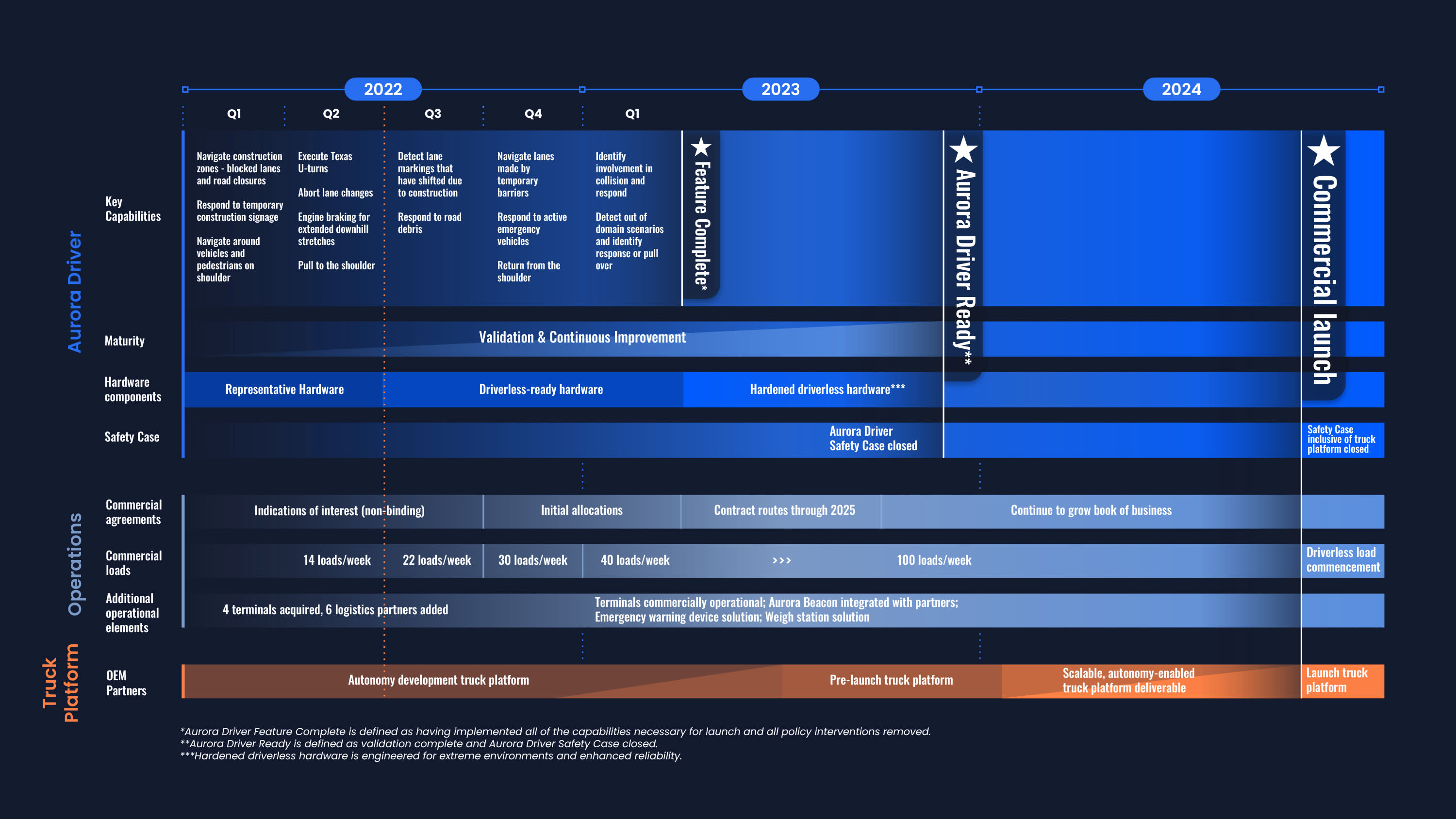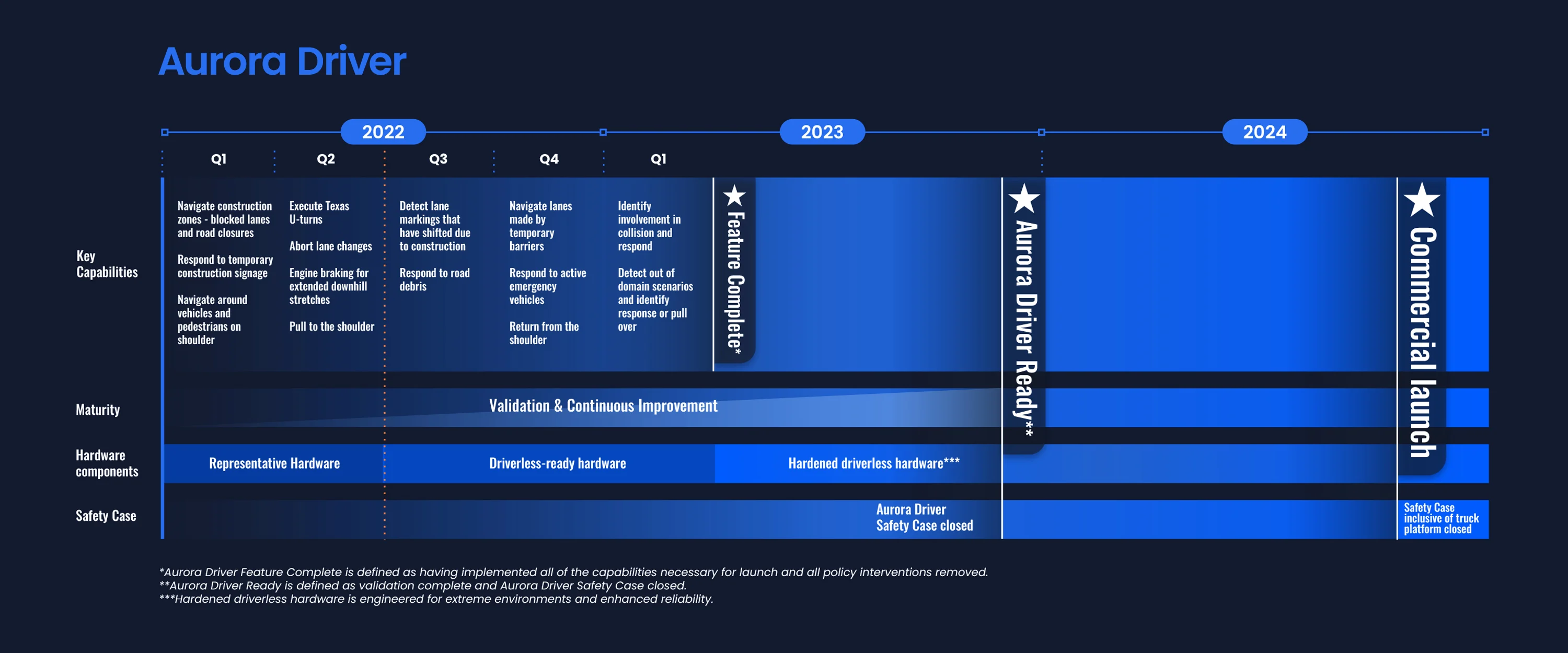Unveiling our Aurora Horizon Product Roadmap
Aurora Horizon | August 03, 2022 | 4 min. read

We see a clear path to a driverless future. Just as we shared our industry-first Safety Case Framework to lead by example and push for improved safety standards, our goal in sharing the work we see ahead on our path to market is to be transparent about the state of our technology and the steps we plan to take to deliver a safe, scalable self-driving product.
In today’s Q2 2022 Shareholder Letter, we introduced Aurora’s Product Roadmap for the commercial launch of our autonomous truck product, Aurora Horizon. Our roadmap outlines the progress we have made so far this year and the work that remains between now and the planned commercial launch of our first product.
How we plan to deliver our scalable autonomous trucking product
To deliver a scalable, commercially viable product, we’ve structured our business around three core components: autonomy technology, vehicle platform, and commercial operations. Our roadmap charts a path for these key components and the dependencies of our business.
Autonomy technology: Prepare the Aurora Driver for solo missions

This section of the roadmap focuses on the software, hardware, and data services that enable the Aurora Driver to run on a vehicle platform, providing an overview of the development and validation of our autonomy technology leading up to launch.
The first row outlines some of the key autonomy capabilities we plan to release to enable the Aurora Driver to autonomously handle our commercial routes. During the second quarter of 2022, we released Aurora Driver Beta 3.0, building off of Aurora Driver Beta 2.0 released in the first quarter of this year and Aurora Driver Beta 1.0 released at the end of 2021. Beta 3.0 includes technical updates that improve end-to-end autonomous operations between our terminals in Texas, such as complex surface street maneuvers and engine braking on long downhill grades. We also demonstrated our fault management capability one quarter ahead of schedule, allowing the Aurora Driver to autonomously detect and respond to system issues while traveling on public highways.
In the second half of 2022, we will focus on developing capabilities that enable the Aurora Driver to handle additional situations like unusual debris on the road, more complex construction zones, and emergency vehicle interactions. Simultaneously, we will continue to mature existing autonomy capabilities and refine the sensors and other hardware elements that enable the Aurora Driver.
We expect to have developed these capabilities by the end of the first quarter of 2023, at which time we’ll consider the Aurora Driver to be “feature complete”—i.e. there will be no more policy interventions during public road tests. Throughout the rest of 2023, we will focus on validation and compiling evidence to support our Safety Case for removing human vehicle operators during autonomous operation.
Vehicle platform: Build autonomy-enabled trucks

This section of the roadmap covers the development of trucks that are purpose-built for autonomous operations.
We have made significant progress since first announcing partnerships with Paccar and Volvo Trucks, two of the top three North American OEMs in trucking, last year. Our teams have defined high-level product and technical requirements, designed interfaces between the vehicle platform and the Aurora Driver, and built initial prototypes of autonomy-enabled trucks. Throughout the rest of 2024, we plan to closely collaborate with our OEM partners to complete the integration and final validation of our Aurora Driver-powered trucks.
Commercial operations: Design an end-to-end service

This final section of the roadmap outlines the operational procedures and foundational infrastructure we plan to have in place to deliver our Aurora Horizon driver-as-a-service product to our customers.
One way we measure our progress in this sphere is by looking at our relationships with pilot customers and partners. We believe that the breadth and diversity of our pilot programs set us apart in the autonomous freight transportation space. These pilots show meaningful interest from potential future Aurora Horizon customers and provide valuable insights that inform our trucking lane expansion and service delivery plans.
Collaboration partners such as U.S. Xpress and Covenant help us understand how autonomous trucks can help existing fleets improve efficiencies and address the growing demand to move goods, while our commercial pilots with FedEx and Uber Freight help us practice commercially-representative operations by delivering real loads for their customers. These pilot customer programs also allow us to continue to develop and test the integration of Aurora Beacon, which includes various backend tools for fleet management and monitoring, positioning us for a smooth roll-out of our product support services.
We announced two new commercial pilots—one with Werner Enterprises, a leading truckload transportation and logistics services provider, and most recently, one with Schneider National, one of the industry’s largest multimodal transportation providers. And earlier this year, ahead of schedule, we also expanded our relationship with FedEx by adding a second lane to our commercial pilot. We are now autonomously hauling FedEx loads daily between our Dallas and Houston terminals, and weekly between our two new terminals in Fort Worth and El Paso.
Throughout the rest of 2022, we expect to continue to scale the number of loads we autonomously haul for our pilot customers, and we plan to begin initial capacity allocations by the end of the year.
Coming soon
By sharing our Aurora Horizon Product Roadmap, we hope to provide more insight into what you can expect from us as we work toward the commercial launch of our first product at the end of 2024.
We are excited to share more updates as we continue to make progress against our roadmap.
Cautionary Statement Regarding Forward-Looking Statements
This blog post contains certain forward-looking statements within the meaning of the federal securities laws. All statements contained in this blog post that do not relate to matters of historical fact should be considered forward-looking statements, including but not limited to, those statements around the timing of availability of an autonomy-enabled truck platform, our ability to achieve certain milestones around the development and commercialization of the Aurora Driver on the timeframe we expect or at all, and potential opportunities with our partners and pilot customers. These statements are based on management’s current assumptions and are neither promises nor guarantees, but involve known and unknown risks, uncertainties and other important factors that may cause our actual results, performance or achievements to be materially different from any future results, performance or achievements expressed or implied by the forward-looking statements. For factors that could cause actual results to differ materially from the forward-looking statements in this blog post, please see the risks and uncertainties identified under the heading “Risk Factors” section of Aurora Innovation, Inc.’s (“Aurora”) Quarterly Report on Form 10-Q for the quarter ended March 31, 2022, filed with the SEC on May 12, 2022, and other documents filed by Aurora from time to time with the SEC, which are accessible on the SEC website at www.sec.gov. All forward-looking statements reflect our beliefs and assumptions only as of the date of this blog post. Aurora undertakes no obligation to update forward-looking statements to reflect future events or circumstances.
Delivering the benefits of self-driving technology safely, quickly, and broadly.